Have you ever considered getting into the world of welding? If so, then MIG welders might have popped up your list, and you are thinking about getting one – which is probably why you are reading this article in the first place.
Thanks to their versatility in home welding use, MIG welders are a great piece of equipment you can own. In fact, they happen to be the most commonly used welding equipment, right above the equally popular TIG (Tungsten Inert Gas) welders and stick welders. Their main advantage is the ease of the method itself – MIG welders are incredibly easy to use and learn from, and are great for anyone who is starting out as well.
However, the increasing numbers of MIG welders also means that you might get confused when you go out shopping for one. From choosing between gas-less or gas models and other considerations, how would you know the best fit for you or what will work to your advantage?
In order to avoid mistakes you will regret, it is important to know how to choose the best one, as well as some suggestions of MIG welders to check out and what makes them so great. We will tackle both of these in this article, so read on for more on that.
Comparison table
[table id=12 /]
Hobart Handler 210 MVP – our pick
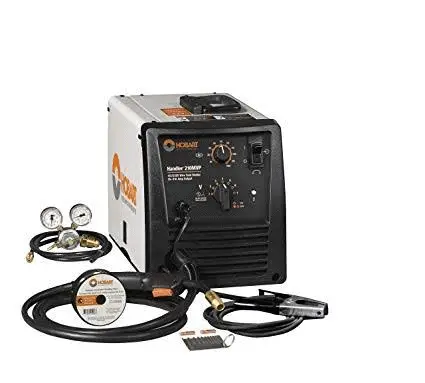
If you are looking for a MIG welder that gives you a good combination of high quality components and a wide amperage range at a budget friendly cost, this is probably the best one you can go for. While it is not the cheapest one on the list, it has a high reputation when it comes to reliability and performance for its price range.
Specs
- Dual voltage (230V/115V), and comes with an MVP plug that makes it easy to plug in anywhere
- 7 settings for voltage to help in fine-tuning
- Single pass welds 24 ga.to 3/8 inch steel
- Has a quick change system of its drive roll
- Duty cycle of 20% when using 115V at 90A, and 30% when using 230V at 150A
It comes with a good range of settings for the amperage, and the wire speeds are at an even larger range. This will also ensure that you have as much control as you need over every job you set out to do, and the machine makes it easier for you as well since it does not require as much skill for you to operate and set up.
It is quite heavy compared to other similar models though, so it will not be as suitable for on-site work or frequent moving to different places. However, this will not be a problem if you are setting it up for a stationary position, since its design is well laid out. Its arcs are also very consistent and smooth, so it will not give you sudden surprises on the job like spatter problems – which is much different compared to MIG welders of lower quality.
Pros
- Very easy to set up and use
- Has good amperage range
- Has the inclusion of high quality parts
- Very affordable while still retaining high quality
- Large range of wire speeds
- Precise welding chart
Cons
- Quite heavy
- Does not include an aluminum spool gun
Verdict
The Hobart Handler 210 welder is suitable for beginners who want a machine they can use to learn the job, as well as experienced welders that want a reliable machine they can trust. It will also give you all that you require from a 210A machine, and this is why it is among the top MIG welders for home use.
View price on Amazon
Forney Easy weld 270 – best for multipurpose welding
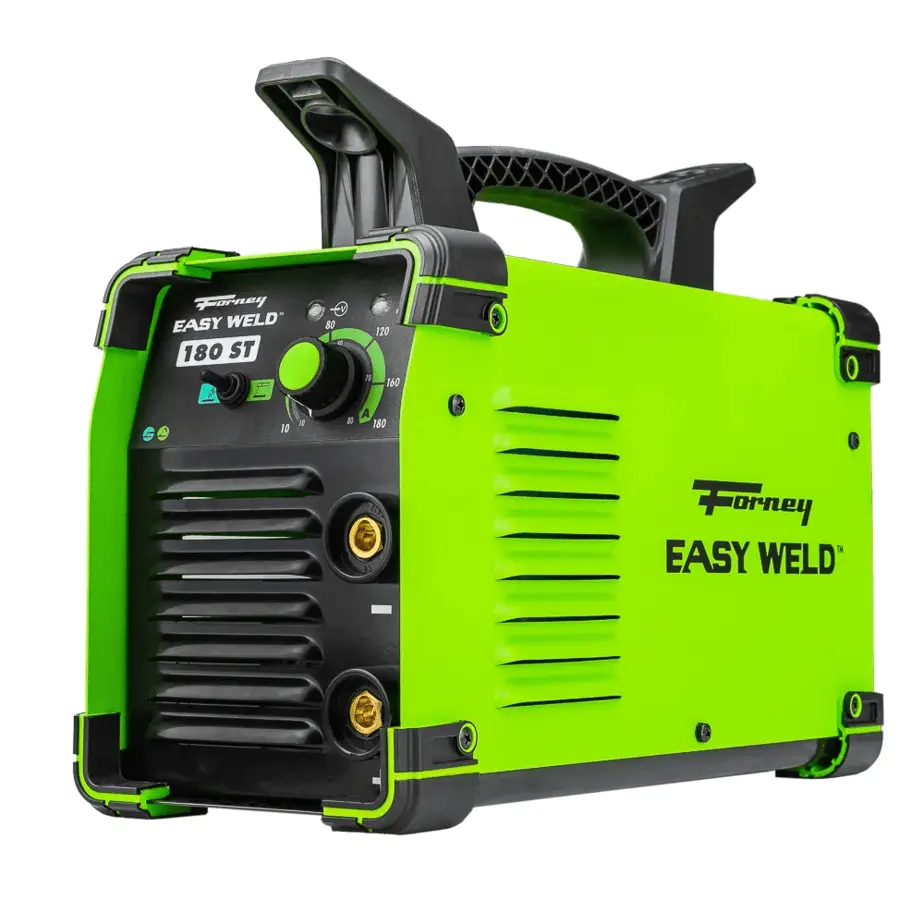
If you are searching for a MIG welder that gives you plenty of value for your money, then this is the best one to go for. It also has a variety of functions you can utilize in your work, even though it is in a smaller size compared to the Hobart 210.
Specs
- Has a 3-in-1 approach, combining TIG, MIG and stick welding
- Infinite voltage capacity and wire feed control
- Three-switch position to allow for quick change in welding processes
- Has both gas and no-gas welding installation
- Generator-friendly with a minimum continuous output of 4500W
- Includes a 10’MIG gun. Adapter (20A to 15A), 8’ ground clamp, and integrated handle with a torch wrap
- 120V input power, with a full output power of 10 to 140A
For a beginner that wants to start learning their craft on a machine that is low in amperage, this is an ideal machine to use. This is because it is simple to learn from, and the instruction manual is comprehensive enough to answer all your questions and make the learning curve easier to deal with – regardless of whether you have welding experience or not.
Among the MIG welders in the market, the 140MP is among the most popular with numerous users, and this is also partly due to its diversity in use – it can even handle TIG and stick welding, though you have to purchase the weld sticks separately. The only disadvantage you might notice is the short length of the leads in the machine, but this is not a major issue as it is hard to find stock leads that are long in length.
The machine is also lightweight and small, which makes it easy to move around. In addition, it can operate effectively on 110V if you do not have access to 240V power sources.
Pros
- Very easy to set up and use
- Lightweight and portable
- Good quality of build
- The instruction manual is comprehensive
Cons
- Short leads
- Low amperage
Verdict
Compared to the Hobart 210 welder, this has a similar arc consistency, quality build, and penetration. If you want high quality arcs without spending too much money on a welding machine, then this is a good pick, keeping its price in mind.
View price on Amazon
LOTOS MIG175 welder – best for lighter tasks
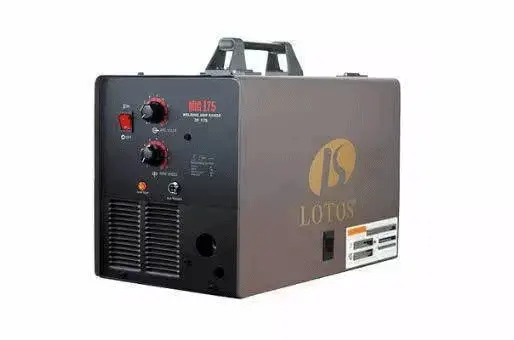
If you want a MIG welder that gives you diversity in your work, even though it might be lower quality than the others on this list. It packs a variety of features that will prove useful to you, such as its aluminum spool. Note that most MIG welders are able to deal with aluminum welding, but few of them will provide you with the soft aluminum wires that you require without a spool gun that is specific to the task – and this is among the few.
Specs
- Multi use, as it can weld stainless steel, aluminum, mild steel, and other metals
- Includes a spool gun and aluminum wire feeder for a more seamless experience
- Rated output of 175A, with input voltage of 220V/240V
- Wire ranges of 0.025 to 0.030 inches, and solid steel range of 0.030 to 0.035 inches
- Includes a flux core and has gas-shielded welding functions
- Dual frequency of 50/60 Hz
The spool gun can feed the wire as smoothly as possible, which means that the results come out without folding unnecessarily. While the machine does not have as long of a warranty as the top MIG ones do, it is still affordable and is even known to outlast its warranty by many years.
The welding results are not at the quality of the top MIG welders, but they are not too far behind either – and any type of easy-to-weld metal will have the tidy beads at the end of the process. The welds are spatter-free too, as long as you are using the correct settings on the job. Even though there might be some spatter on some occasions, it is nowhere close to the extent that poor quality machines have, so that is a worthy tradeoff.
The welding gun and leads are not the best you will ever own, either. In addition, you will not see the use of replacing the connector, as it is unusual and most guns will not fit it entirely. Despite this, this is a welder that will fit you if you are doing lighter work, not the industrial-level work, so you do not need a premium welding torch either.
Pros
- It includes the aluminum spool gun
- Budget friendly and still gives you the basic advantages
- Produces neat welds
- Good choice for hobbyists
Cons
- The MIG gun is not high quality
- Unsuitable for industrial-level use
Verdict
If you require a MIG welder that will help you accomplish your tasks at home, especially for welding aluminum, this will sort out your needs.
View price on Amazon
Miller Electric 907614 welder – most reliable option
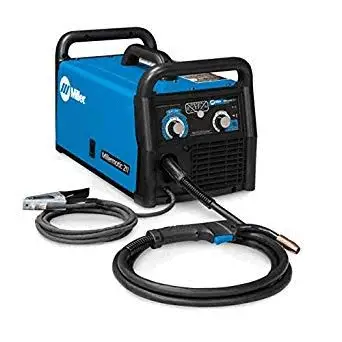
This is a premium build machine that many professional welders trust. Even though it is more expensive compared to the other options on this list, it is widely loved due to its portability, great performance and dependability. It is also versatile enough to be useful in both workshop settings and in outdoor settings.
Specs
- Rated output of 175A with an input voltage of 240VAC
- Mostly handles aluminum, as well as mild steel and steel
- Handles material thickness between 24-gauge to 3/8 inches in one pass
- Spool size of 8 inches
- Hook and loop cord wraps
- Current type used is DC
- Work cable of 3 m and power cord of 2 m
The machine has a distinct smooth start technology, as it will prevent deformed bead profile or spatter when the wire is first forming the arc. This is a feature you will find in larger MIG welders, but this machine is among the few smaller MIG ones that have this feature.
In addition, the inner part of the spool door has a chart, which can help you if you need some extra guidance on the welding specifics, and the voltage dial has a guide that will tell you the amperage you should be using in different circumstances. Considering this, it is understandable that it comes at a higher price than many similar models, and it is even better when you consider that the company has a money rebate if you choose to purchase the machine from any of their recommended dealers.
Pros
- Very high quality of build and work
- Heavy duty
- Long warranty period
- Very good stock MIG gun
- Wide range of settings to work with
- Portable and lightweight
Cons
- Costly
- The ground clamp is not top-notch
Verdict
It is quite challenging to find a reliable MIG welder on the market, but this will ensure that your experience with them does not go sour. The price is higher than most others on the list, but the quality of work it produces makes it a worthwhile pick to work with.
View price on Amazon
GoPlus MIG 130 welding machine – great choice for DIY and hobbyist welders
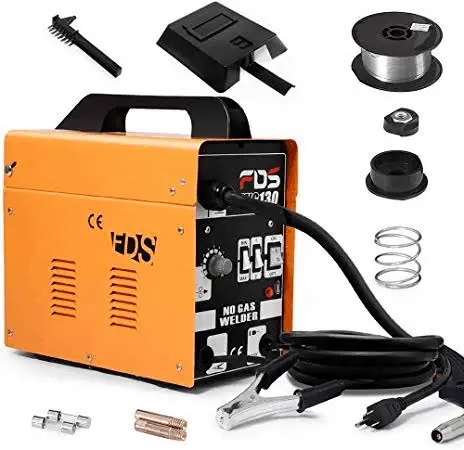
This is a welder that is portable and versatile enough to allow for use in both home and professional settings. It will fit many of your needs, even as it takes up a small part of your storage space. It also makes a good tool if you enjoy making decorations or sculptures, as well as auto body projects and light steel welding.
Specs
- Flux wire and no-gas installation system to prevent oxidation of welded parts
- Adjustable in 4 levels of current flow settings, 4 buttons of 1/2, max/min, wire feeding speeds (10 levels)
- Welding gun with complete safety control, and two air vents to dissipate heat
- Hidden top storage to keep your extra tools
- Metal tip
Thanks to its build and specifications, it can handle a wide array of projects. It uses a voltage of 110V, and has a 72.5-inch long power cord. The maximum output to expect is at 15% when it is running on 105A of power.
The standout feature though would have to be the adjustment settings, which allow you to change things up according to the specific project you are working on. It also has a strong plastic handle and steel frame, which ensures it can handle various conditions without the risk of breaking down quickly.
Another advantage is its portability and versatility. Because it only weighs 35 lbs., moving it around is very easy and you will likely not require extra help to do so. The top handle also enables easier carrying, and the smaller dimensions ensure it does not take up too much space in your workshop.
Note that the package includes a welding mask that measures 9.5 inches x 7.87 inches. While this is a great choice if you are an occasional welder, it will not be enough if you are planning to us it in industrial settings or for professional projects.
Pros
- The cord is long enough to allow you to use it multiple settings
- Handle is plastic and has non-electrification properties
- Heat dissipation mechanism to avoid accidental burns
- Durable frame
- Very affordable
Cons
- Breakers sometimes trip, which can be frustrating
- Welding power is minimal
Verdict
If you are looking for a welder that can meet the needs of your home welding or lighter professional projects, then the Goplus can meet some of those needs. Even though it lacks the power of a professional-level MIG welder, it can tackle any hobby project very well.
View price on Amazon
What we do not recommend
HITBOX MIG gasless welder equipment – has versatility, but low quality build

While this is a machine that comes in quite handy for a beginner or useful as a backup machine, there are a number of disappointing aspects that it has, which is the reason why it is not a good choice.
The good news about it is its affordability, which makes it a god choice for any hobbyist welder. It can operate with 200A of power, and its arc can become hotter than what you would typically get from a 200A machine.
In addition, it can operate for a much longer period compared to other similar machines of the same size. However, it does not have as long of a lifespan, because of its low quality.
It also gives you an option to connect a TIG torch and do some TIG welding if you want, but the preset settings are unfortunately too limited to handle extensive work due to using synergic settings. Instead of giving a wide variety of settings, it comes with predetermined specified settings, which then dictate the amperage you can run and wire size to use.
The setting style is good if you are a learner, because you do not necessarily need to know the correct amperage rate to wire speed. The bad news is that you can only choose between two metric wire sizes, unlike most synergic machines that have multiple wire speed adjustment settings.
Merits
- Can handle both MIG and TIG welding
- Affordable
Demerits
- Low warranty period
- Inconsistencies in the results and the product
- The lifespan of the welder is short
- Limited setting adjustments
Verdict
If you are looking for a 200A machine that has beautiful welds, this can be an option to consider. However, it is not something you would consider first, as there are plenty of similar machines that have a higher quality of build and work.
View price on Amazon
What to look for in a MIG welding machine
MIG welders are considered as the easiest you can use when carrying out a welding project at home, even more so than TIG or stick welders. However, not all welding tasks are created equal – so it is important to know why you are getting a welder for the job.
There are many considerations you should keep in mind when you are thinking of purchasing a MIG welder. But the first important thing is to understand the process of MIG welding and how it works, and then search for a machine that suits those needs.
What is MIG welding about?
Also known as Metal Inert Gas welding, it is a GMAW (Gas Metal Arc Welding) method that utilizes an electrode that is comprised of continuous solid wire. This is then heated, and you use a welding gun to feed it into a molten weld pool.
In the weld pool, the two base materials will fuse together, and the new fusion is sealed from oxidation or contamination using an inert gas (usually argon). When the weld pool cools, it leaves the result clean and the metals stronger. The process is largely seen as a semi-automatic process, because the arc length and wire feed rates are under the control of the power source, while the wire position and travel speed is under your manual control.
The first patents of the method were in the late 1940s, and it was primarily used for welding aluminum, although later years saw the introduction of other shielding gases rather than helium.
A typical MIG welder will have a number of different settings, which will allow you to set the machine to the correct power that gives you good penetration and high quality work without burning holes in the metals.
Types of welders
Welders are of 4 types, and each has their advantages and disadvantages.
MIG welders
These are among the easiest welders to learn from and use, and they come in two varieties – flux core and bare wire, with some having both. The bare wire types will need a gas supply in order to shield the weld, while flux core types can work in outdoor settings because they do not need gas supplies to operate.
MIG welders all use spools of wire, which you feed into the metal using a ‘gun’. This creates an electric arc that welds the metal.
Arc (Stick) welders
These are the most basic type of welders, and are easy to use when you get the hang of using them. They are not as expensive as other methods.
It works by using a stick electrode rod, which has a coating of metal powders and compounds. You then make electric arcs by feeding electric current into it and connecting it to the metals.
Gas welder
These use oxy-acetylene gas which generates a flame, and this melts the steel. It can also be useful in welding other metals such as bronze, silver and copper, as well as thicker metals.
TIG welders
It stands for Tungsten Inert Gas welder, and they require a two-hand job. One hand holds the torch, while the other feeds the filler rod. They are mainly used for welding aluminum, titanium, alloys and steel due to their high-quality finish.
What to look for in a MIG welder
Input power
This is the first and most important aspect to think about – the power the welder is producing. The input voltage is the power your welder will operate on, so it is important to remember that not all welders will work with the power sources that your workshop has. If you find a welder that uses a power input of 110-140V, then this is the most favorable for home use because standard household power outlets have this range.
Other than that, some cheap and more expensive welder will only operate at power inputs of 220V – otherwise, they can switch to higher voltage. For cases like these, you will need different kinds of outlets.
Duty cycles
This will determine the efficiency levels of the machine, as it is a measure of the length of time the machine can weld in order to optimize its lifespan. The percentages you see may be different, but the standard way to look at it is in increments of ten-minute time spans.
For instance, if you have a machine that has a duty cycle of 30% at the correct amperage measurement, then you should use it for three minutes and then allow it to cool down for the remaining seven minutes before repeating. The same case applies for other duty cycles; if it is 35%, for example, you should run it for three and a half minutes and then let it rest for six and a half minutes.
Different duty cycles will depend on the amperage indicated, so this will change for different welders. In order to adjust the amperage, you can do this by adjusting the dial present on the machine.
Machine weight
This might be a smaller factor to consider, but it is still important to think about. If you are buying a machine that is 50 pounds or less, it is easily portable – but it might still need a wheeled cart in order to move it without struggle.
Protection from Thermal overload
This will not necessarily be present in all MIG welders, though some have it. It is a handy feature that inc4reases user safety when using it, as it prevents the welder from overheating and shutting down – although you should still always wear your welding mask and helmet while using it.
Other MIG welders will have a cooling fan when overheating occurs, if they do not use this method. At the end of the day overheating has numerous risks to it – it forces you to waste more time while allowing the machine to cool down, and it leads to an increase in shielding gas consumption. Therefore, if you can find a thermal overload protection mechanism in a welder, it is best to get it.
The metals it can handle
Different MIG welders can handle different metals – while some focus on one metal, others can do several efficiently. The usual metals you will find MIG welders handling are aluminum, stainless steel, and mild steel, while some welders can handle cast iron, iron, and some alloys.
Thickness of the materials/metals
There is only so much you can expect a metal gas inert welder to handle. As a general rule, MIG welders can comfortably handle thinness of 0.0239 inches (24 gauge) or 0.0478 inches (18 gauge), and maximum thickness of 1.2 inch or 3/8 inch. If you are welding metals that are thicker than this, you are better off getting a stick welder machine.
Final thoughts
Choosing a good MIG welder requires the consideration of several factors, and some are common to other welders as well. Regardless of your choice, ensure that it works well for your needs and fulfills your requirements, and do the proper research before making a decision that will last you for a long time.
